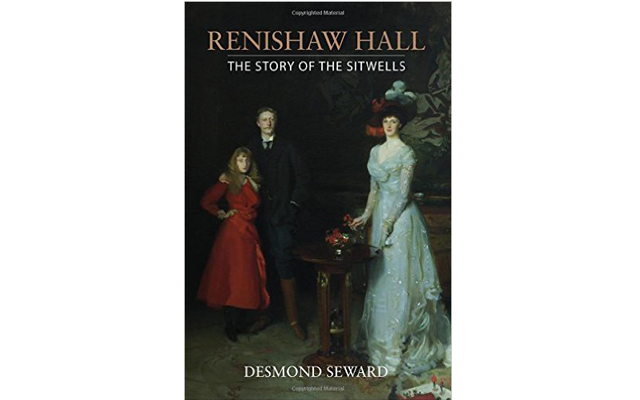Book review: Renishaw Hall
John Martin Robinson welcomes this tales of a most colourful English family and its home.


Renishaw Hall by Desmond Seward (Elliott & Thompson, £25 *£22.50)
Renishaw, the home of the Sitwells, is famous for ‘the Trio’: Osbert, Edith and Sacheverell, who played such a brilliant role in 20th-century English cultural life. Naturally, they are well covered, but the hero of this book is not them, but their eccentric father, Sir George, the author of a masterpiece, On the Making of Gardens. There is also a cast of benevolent, hot-tempered predecessors: an Iron Master, a Cavalier, scholar squires, a Regency buck.
The Sitwells were originally yeomen who made their fortune in the Derbyshire nail industry. In the mid 17th century, their iron works near Eckington was one of the largest in England. This was the achievement of George ‘the Cavalier’, an educated man who built the core of Renishaw in 1619. His descendants were Whiggish landowners with hobbies such as algebra, who improved their estates and married heiresses, ‘providing the strange family names affected by later generations’, as Sacheverell wrote.
The male line ended with the death of William Sitwell in 1776 and Renishaw passed to his nephew, Francis Hurt, who took the Sitwell name and arms by Royal Licence. He was, by contrast, a Tory and a Jacobite. His son was called Sitwell Sitwell. (Evelyn Waugh, referring to Osbert’s touchiness, quipped he should revert to family tradition and call himself Sir Hurt Hurt.) The ironworks was sold in 1791.
Sitwell Sitwell, the 1st Baronet, was a classic Regency figure with impeccable taste in architecture and pictures, strings of horses and mistresses and a pack of harriers that killed a Bengal tiger escaped from a circus. He enlarged Renishaw, built the stables and other outbuildings, probably to his own design assisted by Joseph Badger of Sheffield. Naturally, he left the estate seriously encumbered.
The inevitable collapse occurred in the time of his son, Sir George, as a result of inherited debts and the failure of a Sheffield bank. His successor, Sir Reresby, a cornet in the Life Guards and gifted water-colourist, tried to sell Renishaw, but failed to find a buyer. His wife, Louisa Lucy Hely-Hutchinson, shrewd, determined and imaginative, saved the wreckage.
They were drawn to each other by evangelical religion and it was an ideal match, although he died after only five happy years. Fortunately, she loved ‘the grand old house’ and saved it for her son, the great Sir George, 4th Baronet of Renishaw. She had a head for business, inspired devotion and had a dependable lawyer, cherished servants and good land agent, Peverill Turnbull, who also acted as young George’s tutor before he went to Eton and Oxford. Aged four, he told a stranger with hallmark self-confidence: ‘I am the youngest baronet in England!’
Exquisite houses, the beauty of Nature, and how to get the most from your life, straight to your inbox.
A newly discovered valuable seam of coal on the estate saved everything, as well as funding her charities and annual Christmas ‘breakfast’ for the postmen of Scarborough. Her son inherited some of her finer qualities. Six feet tall, ginger, highly educated, self-centred, grand, aloof, but with ‘plenty of charm if needed’, he was the epitome of God’s greatest breed: an educated ‘late Victorian upper-class Englishman’.
He married Ida, daughter of Lord Londesbrough, so attracted by her Grecian looks and ducal quarterings that he overlooked her brainlessness. She was not without wounding wit, uttering the immortal putdown: ‘Remember George that baronets are the lowest of the low.’ (Not quite true: esquires are.) The marriage was, of course, disastrous. Ida did not share her husband’s interests and was uncontrollably extravagant. George had a nervous breakdown, but reinvented himself as a castle owning antiquarian in Italy and the creator of modern Renishaw, with its terraced garden and Baroque palazzo furnishings.
Their children, the literary trio, are so well known that there is no need to mention them, but they are dealt with fairly in this balanced and beautifully written book. Sir George is rightly the main focus of Desmond Seward’s research. This new work is an unexpected thing: original and full of new information, as well as a delightful read.
* Buy Renishaw Hall in the Country Life Bookshop
To order any of the books reviewed or any other book in print, at discount prices* and with free p&p to UK addresses, telephone the Country Life Bookshop on 0843 060 0023 or visit www.countrylife.co.uk/bookshop. Or send a cheque/postal order to the Country Life Bookshop, PO Box 60, Helston TR13 0TP. For overseas readers, telephone 01326 569444 or email sales@sparkledirect.co.uk * See individual reviews for CL Bookshop price.
Country Life is unlike any other magazine: the only glossy weekly on the newsstand and the only magazine that has been guest-edited by His Majesty The King not once, but twice. It is a celebration of modern rural life and all its diverse joys and pleasures — that was first published in Queen Victoria's Diamond Jubilee year. Our eclectic mixture of witty and informative content — from the most up-to-date property news and commentary and a coveted glimpse inside some of the UK's best houses and gardens, to gardening, the arts and interior design, written by experts in their field — still cannot be found in print or online, anywhere else.
